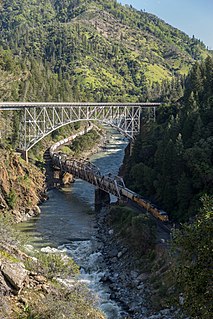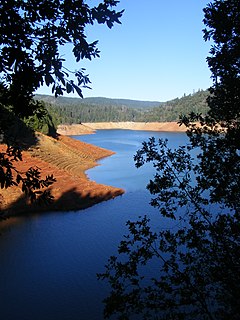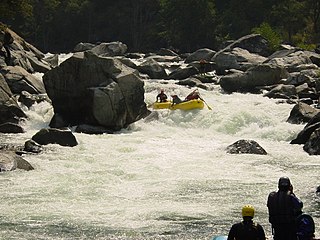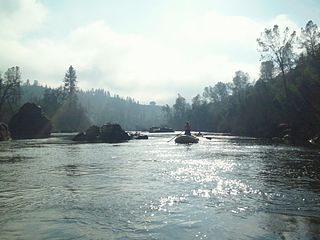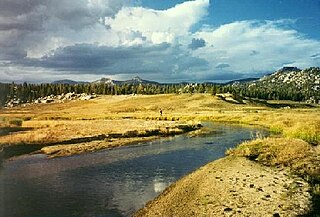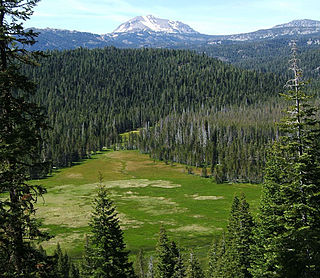| North Yuba River | |
|---|---|
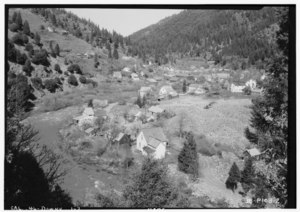 The North Yuba at Downieville, c. 1934 | |
 Map of the Yuba River watershed, including the North Yuba River | |
| Location | |
| Country | United States |
| State | California |
| Physical characteristics | |
| Source | Yuba Pass |
| - location | Near State Route 49, Sierra Nevada |
| - coordinates | 39°37′03″N120°29′53″W / 39.61750°N 120.49806°W |
| - elevation | 7,018 ft (2,139 m) |
| Mouth | Yuba River |
- location | West of North San Juan, Yuba County |
- coordinates | 39°22′07″N121°08′11″W / 39.36861°N 121.13639°W Coordinates: 39°22′07″N121°08′11″W / 39.36861°N 121.13639°W |
- elevation | 1,129 ft (344 m) |
| Length | 61 mi (98 km) |
| Basin size | 489 sq mi (1,270 km2) |
| Discharge | |
| - location | above New Bullards Bar Reservoir [1] |
| - average | 1,248 cu ft/s (35.3 m3/s) [2] |
| - minimum | 78 cu ft/s (2.2 m3/s) |
| - maximum | 63,400 cu ft/s (1,800 m3/s) [3] |
The North Yuba River (also called the North Fork Yuba River) is the main tributary of the Yuba River in northern California in the United States. The river is about 61 miles (98 km) long [4] and drains from the Sierra Nevada westwards towards the foothills between the mountains and the Sacramento Valley.

The Yuba River is a tributary of the Feather River in the Sierra Nevada and eastern Sacramento Valley, in the U.S. state of California. The main stem of the river is about 40 miles (64 km) long, and its headwaters are split into three major forks. The Yuba River proper is formed at the confluence of the North Yuba and Middle Yuba Rivers, with the South Yuba joining a short distance downstream. Measured to the head of the North Yuba River, the Yuba River is just over 100 miles (160 km) long.

Northern California is the northern portion of the U.S. state of California. Spanning the state's northernmost 48 counties its main population centers include the San Francisco Bay Area, the Greater Sacramento area, and the Metropolitan Fresno area. Northern California also contains redwood forests, along with the Sierra Nevada, including Yosemite Valley and part of Lake Tahoe, Mount Shasta, and most of the Central Valley, one of the world's most productive agricultural regions.

California is a state in the Pacific Region of the United States. With 39.6 million residents, California is the most populous U.S. state and the third-largest by area. The state capital is Sacramento. The Greater Los Angeles Area and the San Francisco Bay Area are the nation's second- and fifth-most populous urban regions, with 18.7 million and 9.7 million residents respectively. Los Angeles is California's most populous city, and the country's second-most populous, after New York City. California also has the nation's most populous county, Los Angeles County, and its largest county by area, San Bernardino County. The City and County of San Francisco is both the country's second-most densely populated major city after New York City and the fifth-most densely populated county, behind only four of the five New York City boroughs.
It rises on the Sierra Crest about 8 miles (13 km) northwest of Sierraville. The river flows west through meadows, then south into a gorge, turning west again, followed by California State Route 49. The river's four major tributaries, the Downie River, Goodyears Creek, Canyon Creek and Slate Creek, enter from the right before the river abruptly turns south at the New Bullards Bar Reservoir, formed by the New Bullards Bar Dam. The dam is situated right above the river's mouth; just after the North Yuba leaves the dam it empties into the Middle Yuba River and forms the Yuba River.
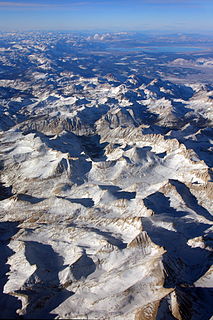
The Sierra Crest is a ~500 mi (800 km) generally north-to-south ridgeline that demarcates the broad west and narrow east slopes of the Sierra Nevada (U.S.) and that extends as far east as the Sierra's topographic front. The northern and central Sierra Crest sections coincide with over 300 mi (480 km) of the Great Basin Divide, and the southern crest demarcates Tulare and Inyo counties and extends through Kern County to meet the Tehachapi crest. The Sierra Crest also forms two paths (bifurcates) around endorheic cirques between the west and east Sierra slopes.

Sierraville is a census-designated place in Sierra County, California, United States. It is at the southern end of the huge Sierra Valley which is used primarily as pasture and is also at the junction of California State Route 49 and California State Route 89 southwest of Loyalton. Sierraville has a post office with ZIP code 96126. The post office opened under the name Sierra Valley in 1862 and became known as the Sierraville post office in 1899. The population was 200 as of the 2010 census.

State Route 49 is a north–south state highway in the U.S. state of California that passes through many historic mining communities of the 1849 California gold rush. Highway 49 is numbered after the "49ers", the waves of immigrants who swept into the area looking for gold, and a portion of it is known as the Gold Country Highway. This roadway begins at Oakhurst, Madera County, in the Sierra Nevada, where it diverges from State Route 41. It continues in a generally northwest direction, weaving through the communities of Goldside and Ahwahnee, before crossing into Mariposa County. State Route 49 then continues northward through the counties of Tuolumne, Calaveras, Amador, El Dorado, Placer, Nevada, Yuba, Sierra, and Plumas, where it reaches its northern terminus at State Route 70, in Vinton.
